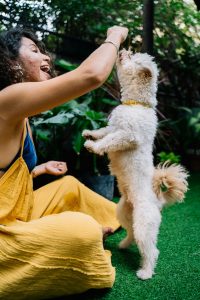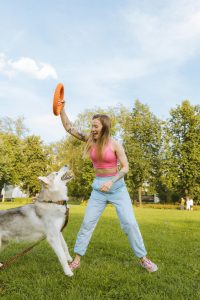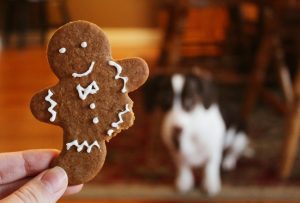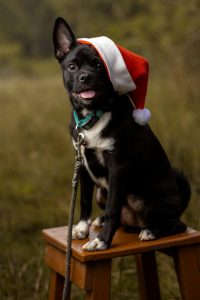You have probably seen dog agility on YouTube, television, or even at a live event. If you have been lucky enough to attend a local agility competition in person, you know how great it is. It looks and feels like a fun activity you can do with your dog. Well, that is true. Dog agility is one of the most popular canine sports in the United States at the moment.
And the best part is, you can do it with every dog. Yes, there are some dog breeds that excel at an agility trial. But you can turn any puppy into a good agility dog. Heck, I’ve seen even some French bulldog puppies and English bulldog puppies do well in agility.
Yes, you have your Border Collie, Jack Russell terrier, Golden Retriever, and others. Today, however, we will not talk about dog agility competition. We will talk about how you can do some agility exercise at home.
With agility, you can also practice some basic obedience training. Here are some ideas and tips on how to get started.
Set your dog to win
Unlike behavior training where you teach commands and cues like leave it, come, and similar, agility is pure fun training. You do not have to stress over how quickly your dog learns the new skill or even doesn’t learn it.
The most important part here is to set up your dog to win. That is important in basic obedience training as well, but in agility training, you definitely want to set up your dog to win.
Ensuring your dog is successful in agility improves the puppy’s confidence. Remember, some dogs need more time to learn.
How to set up your dog to win? By starting small and then raising your expectations slowly. Ask any American kennel club trainer or agility competitor. They will tell you to keep the training session short, no more than five or ten minutes at a time. Make sure to keep it short and fun. This way your dog doesn’t lose interest.
Improve your bond and learn to get his attention
Yes, you might think your dog should focus on the agility obstacle course. But without attention to you, his handler, your puppy will fail.
Before you can even start with agility training and agility exercise at home, you have to learn how to get your dog’s attention. Your dog should focus on you despite distractions, surroundings, and contact obstacles.
You can do that by learning the cue/command “watch me” or “look at me”. Some dogs give instant attention to you by just saying their name.
Move on to tricks
Now that you have your dog’s attention, you are ready for some dog agility training tricks. Start small. There are tricks that help with dog sports greatly. For example, you can teach your dog to touch your hand with its nose. Then you can teach your dog to touch a target with its nose.
Now, by moving your hand or choosing a strategic target placement, you can easily move your dog or adjust his position.
This trick will come in handy when you want to enter your dog into a contact zone at the end of an agility obstacle course. Now, you might not need it at home, but if you want to try real agility skills outside, you need this trick.
Another trick you can learn is teaching your dog to walk backward. Backing up teaches your dog basic body awareness as your pup must pay attention to what all four paws are doing.
Try some spins for flexibility
Here is another dog exercise you can try at home. Get your puppy twirling by learning spin. Your pet can go left or right.
Use your touch hand with a nose targeting trick to lead your puppy in a circle. See? All the tricks are linked and connected.
Another agility trick you can try at home is weaving a figure eight around your legs. It is a great exercise for flexibility and it will prepare your puppy for the weaving pole agility obstacles later on.
Let’s finish off with turn around it. You can also use this exercise for practicing recall. You can use a cone, barrel, or even a garbage can to send your dog out and around the object. Check my go round article to learn how to teach your dog this exercise.
Help your dog with the fear of the dark
Some dogs do not have a problem running through a tunnel for the first time. But most of them are intimidated by the dark opening. This is the reason not many puppies excel at dog agility sports. They cannot go through the tunnel.
It is one of the hardest exercises in dog agility. How to do it at home? Drape a blanket over spaced-out chairs and teach your dog it is fun to walk to the other side. Keep the length short in the beginning so that your puppy can see the other side. Some dog trainers put the dog at one side, and the dog owner at the other side so that the puppy comes to the owner. You can try that trick as well.
This exercise will also help your dog get comfortable with being in a covered space.
Increase body awareness
We talked about how you can use puppy agility for flexibility, but you can also use it for body awareness. One of the simplest exercises is to teach your dog to put its paws on an object. Use an upside-down sturdy box, plastic bin, or anything else to encourage your puppy to interact with it.
Then, move to making your puppy put its front paws on the object. The last objective is for your dog to sit on the object.
Jumping for Joy
If you have ever watched an agility course, you know jumping is a critical agility skill. But it is also one that will provide plenty of physical exercise on a rainy day.
At home, you can use a broomstick or other pole and balance it between two low objects. For example, use a stack of books or flower pots. Remember, never practice this exercise on a slippery surface. You might risk an injury. Also, make sure that the pole will fall if your dog accidentally hits it.
Personally, since I have a small dog, I use my legs as an obstacle for jumping over and going under them. This is what me and Milo practice often at home. It is a great bonding experience, but also a way to burn some energy.
Introduce weave poles
Let’s finish off our at-home dog agility course with some weave poles. This is the most challenging agility exercise. You will need to guide your dog. At home, you can easily set up a weave pole course using tomato stakes or similar poles into the ground outside. Just space them at a decent distance so it is easy for your puppy. As your pup gets better, reduce the distance.







